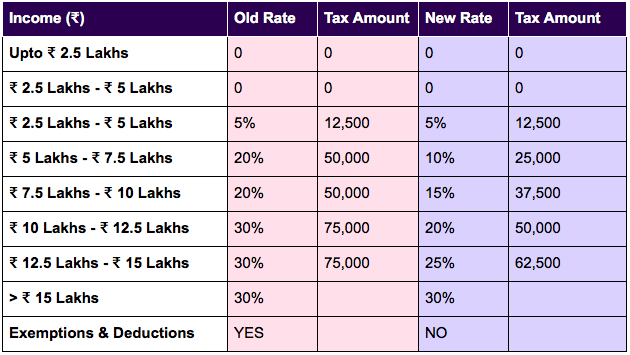With the introduction of the new personal income tax regime for individual taxpayers in The Union Budget 2020, most of us are facing the dilemma of choosing between the new and the old tax regime. “Which one will benefit me more?” This question will inevitably be on top of every taxpayer’s mind, and part of dinner-table conversations in the tax filing season of the financial year 2020-21. The confusion is natural as there is no straight forward answer to this question.
To give you a bird’s eye view, the new tax regime has lower tax rates but has no benefit of deductions – standard deduction, 80C, 80D, etc. Hence, generally speaking if you claim enough deductions, you can reap higher benefits from the old tax regime. However, if you would like to hold on to a higher amount of disposable cash and not invest in tax deductible instruments, the new regime suits you better.

In order to definitively say whether the new or the old regime is better for you, we will need to go deeper into the numbers.
FY 2020-21 Tax slab comparison:
The tax rates in the new regime have been reduced by 5-10%, especially for the lower tax slabs, as can be seen from the table below. The exemptions and deductions have however been removed.

Income (₹)
Old Rate
Tax Amount
New Rate
Tax Amount
Upto ₹ 2.5 Lakhs
0
0
0
0
₹ 2.5 Lakhs – ₹ 5 Lakhs
0
0
0
0
₹ 2.5 Lakhs – ₹ 5 Lakhs
5%
12,500
5%
12,500
₹ 5 Lakhs – ₹ 7.5 Lakhs
20%
50,000
10%
25,000
₹ 7.5 Lakhs – ₹ 10 Lakhs
20%
50,000
15%
37,500
₹ 10 Lakhs – ₹ 12.5 Lakhs
30%
75,000
20%
50,000
₹ 12.5 Lakhs – ₹ 15 Lakhs
30%
75,000
25%
62,500
> ₹ 15 Lakhs
30%
30%
Exemptions & Deductions
YES
NO
Looking at the above table in isolation would however be misleading. You need to take into account the impact of the deductions under the old tax regime on your overall taxes payable in order to make your final decision.
Impact of deductions on your taxes under the old regime
We will look at four different scenarios – low, medium, high and very high deduction levels – to determine how the various levels of deductions affect your taxes payable under both regimes. Let’s see how these scenarios play out for Raj, a working professional with a pre-tax annual income of Rs 12,00,000.
Low deductions
Pre-tax income = Rs 12,00,000
Deductions:
- Standard deduction = Rs 50,000
Tax payable:
- Old regime = Rs 157,700
- New regime = Rs 115,000
Medium deductions
Pre-tax income = Rs 12,00,000
Deductions:
- Standard deduction = Rs 50,000
- Deduction from interest on home loan = Rs 50,000
- Deductions under 80C = Rs 80,000
Tax payable:
- Old regime = Rs 118,500
- New regime = Rs 115,000
High deductions
Pre-tax income = Rs 12,00,000
Deductions:
- Standard deduction = Rs 50,000
- Deduction from interest on home loan = Rs 100,000
- Deductions under 80C = Rs 150,000
Tax payable:
- Old regime = Rs 92,600
- New regime = Rs 115,000
Very High deductions
Pre-tax income = Rs 12,00,000
Deductions:
- Standard deduction = Rs 50,000
- HRA exemption = Rs 250,000
- Deductions under 80C = Rs 150,000
- Deductions under 80D = Rs 50,000
Tax payable:
- Old regime = Rs 52,400
- New regime = Rs 115,000

As can be seen from the four situations illustrated above, it would be advantageous to go for the new regime if you fall under the low to medium deduction ranges. On the other hand, the old regime would serve you better for high to very high deduction ranges.
Bottom Line
The verdict on which tax regime is better is completely dependent on your exemptions and deductions levels. While there is no clear winner, the removal of deductions and exemptions in the new tax regime presents a considerable caveat. This means if you find the new regime more suitable for you after running the numbers, it may be possible that you are not leveraging the full potential of your deductions and exemptions through strategic investments, insurance and other solutions. It would be prudent to take this into account before deciding which tax regime to go for.
We will be coming up with tools to help you make these decisions and expand your horizons to the options available to you to maximize your tax savings. Stay tuned!